The information on this page is drawn largely from a photocopy of a catalogue dating from the early 1920s which I had from Kay Meader. The photo illustrations have not reproduced well from the photocopy and I have used only the least murky. The only other source is a brief article by Basil Harley that appeared in Model Boats in May 1993.
The Winford range of toy boats had a brief life in the 1920s and a few of the smaller sizes survive. They were produced by a Black Country metal bashing firm called Kingswinford Forge Ltd of Kingswinford, Staffs. The hull shells were metal stampings and must have involved substantial tooling investment and therefore the expectation of quite large sales to justify the expense. Basil Harley suggests sales in the high hundreds or low thousands would be needed to cover the tooling costs. Basil made this estimate without any knowledge of the retail prices that the firm charged. We now know that the smallest and simplest 12 inch model sold for ten shillings (50p) and the largest, 36 inch one, for £6. These may not look like very high prices, but adjusted for the rise in average earnings, which is as good a measure of ‘affordability’ as we can get, they are the equivalent of £89 and £1074 respectively. These were not cheap toys and it may be that they were financially viable on smaller sales than Basil assumed. On the other hand the prices are broadly comparable with those for wooden hulled sailing models in the Stevens’s Model Dockyard catalogue of 1924
The decks were wood and the rigs entirely conventional. They are, as far as is known, the first application of metal pressing to toy yacht production, preceding both the Triang tinplate boats of the late 1930s and post-war years and the post-war Ailsa range, which were stamped in aluminium. There were of course tin plate powered models dating from before 1914 by European firms such as Märklin, Bing and Carette.
As well as their innovative production technique, Winford boats all had a unique system of detachable wooden keels and lead ballasts, secured to the hull by bolts through tubes in the hull. This permitted the substitution of deeper keels and/or heavier ballasts to suit the weather conditions on the day. The catalogue gives a registered design number and says that a patent has been applied for, but neither can now be traced in The British Library or the National Archive. The range was advertised as ‘the any weather yacht’ and all but the simplest models had a range of different rigs to suit different wind strengths.
We don’t know exactly when the business started, nor when it closed down. The parent company seems to have had only a brief existence under the Kingswinford name. It appears in the relevant local trade directory for 1921, but is not there in 1916, nor in 1924. Whether it disappeared or was taken over by another company is now impossible to determine. Nor is it possible to judge how large an element the model yacht production was in the company’s business. They participated in a 1923 British Industries Fair, advertising their range in The Toy and Fancy Goods Trader as ‘the finest selling models on the market’ and ‘far and away the best value for money of any Model Yacht on the market’. The Toy Trader gives them a glowing puff in the issue in which they advertise their presence at the 1923 British Industries fair but they have left no other trace in the literature that I have seen.
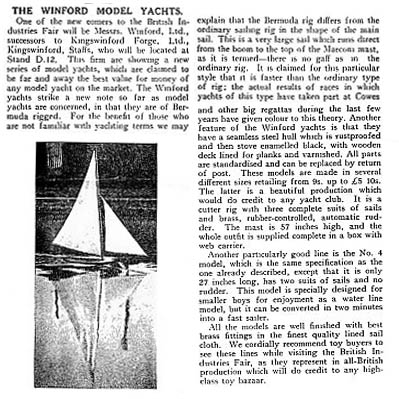
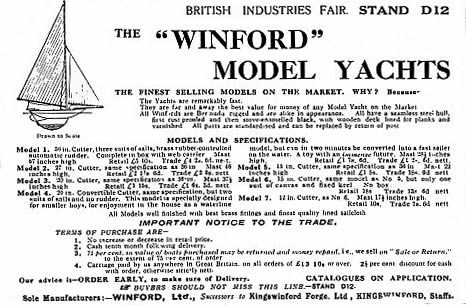
The catalogue is a substantial document of 16 pages, of which three are given over to a detailed price list of a complete range of components and spare parts. To assemble the boat at home from a complete set of parts would have been slightly more expensive than buying one complete. There is also provision for returning the model to the factory for overhaul at the end of the season. This would involve, among other fettling, checking the seal between deck and hull and re-varnishing the deck.
There is much more written matter than is usual in such catalogues and it tells how the original model, a 20 inch boat, was introduced to great success in the summer of 1922 and ‘sold over 300 in the first few weeks’. World wide sales are claimed; ‘to Egypt, Malta, Australia, New Zealand, etc’.
The opening page offers what today would be called a ‘mission statement’ that is extremely ambitious and of a high seriousness that is not quite what one expects of a commercial toy maker.
The text goes on to discuss the practical advantages of Bermuda over gaff rig, the need or otherwise for a controllable rudder and the aesthetic attractions of the schooner rig in a way that suggests that the writer had considerable experience of sailing models.
The range offered in the catalogue includes examples at 12, 15, 20, 27 and 36 inches. But not a 10 inch model as described in Basil’s article; it is possible that this is a misprint in the Model Boats text, as there are other typos that have escaped the copy editor’s eye. As Basil’s boat is described as having three suits of sails, it seems much more likely that it is a 20 inch model.
The complete range looked like this
-
12 inch ‘Ordinary’, fixed single keel and lead, no steering facility, one suit of sails. 10s
-
12 inch ‘Special’ with two suits of sails and spars to match, removable keel and ballast, allowing for substitution, a carrying box and a weighted rudder 16s
-
15 inch ‘Ordinary’, fixed single keel and lead, no steering facility, one suit of sails 18s
-
15 inch ‘Special’ with three suits of sails and spars to match, removable keel and ballast, allowing for the substitution, a carrying box and a simple sheet to tiller steering gear. £1 5s
-
20 inch ‘Racing’ model with three suits of sails and spars to match, removable keel and ballast, allowing for substitution, a carrying box and a sheet to tiller steering gear. £1 15s
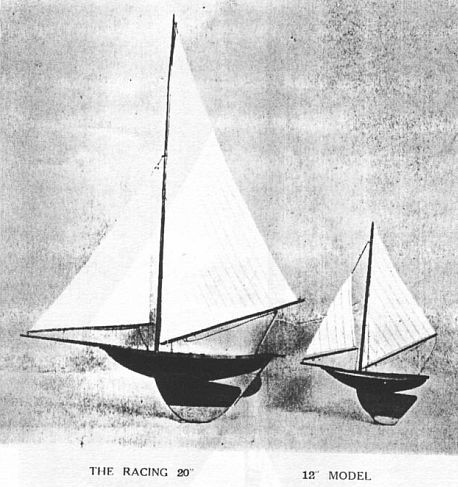
-
27 inch model with three suits of sails and spars to match, removable keel and ballast, al lowing for substitution, a carrying box and a sheet to tiller steering gear £2 17s 6d
-
36 inch model with three suits of sails and spars to match, removable keel and ballast, allowing for substitution, a carrying box and a simple sheet to tiller steering gear. £5 10s
-
36 inch model rigged as a schooner with two suits of sails, removable keel and ballast, steering gear. £6
As mentioned above, these were high prices relative to earnings of the period, but not markedly out of line with what other high class suppliers were charging.
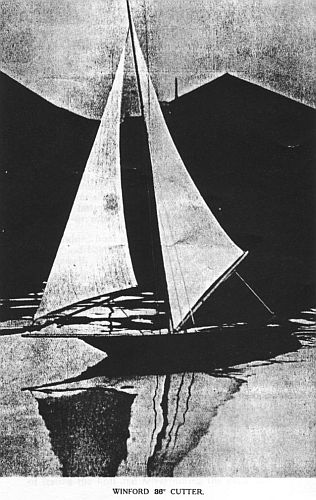
The construction system is shown in the drawing below. The next following illustration shows the complete boat. All were of essentially similar design, differing only in scale. Unfortunately, no illustration is given of the schooner variant of the 36 inch model, described as having the masts set far apart and heavily raked ‘resembling on the water one of the old swift piratical schooner’, so we don’t know exactly how it differed from the standard form. It will be seen that in all sizes, the sail area was really quite considerable for a toy, but these are the top suits and the ballast provision is very substantial. These are much more like ‘a proper model yacht’ than a seaside toy boat. The sophistication of the concept is quite remarkable. If all the rig and ballasting options are deployed, there are no less than 12 options from which to choose the sail area and ballast most appropriate to conditions on the day. Serious racing classes have never had this range of options.


Though the catalogue is ambitious and promises much, the firm and its boats seem to have had only an ephemeral existence. Relatively few examples have survived, and these all in the smaller sizes. So far as we are aware no example of anything bigger than 20 inches is known. It looks as though, despite the company’s claims and the enthusiastic letters from satisfied customers included in the catalogue, it failed to make a lasting impact on the market.
The paragraphs above were all written before I had seen an example in the flesh. The most immediate impression when I did was how ‘big’ the hull is, with lots of beam and depth and thus a high displacement. The other is the quality of the sails, made of a heavy cotton cloth with a woven in blue line. The box, of which much is made in the catalogue, is made of poor quality wood, and poorly finished. There is no attempt to glue the joints at the corners, which are held by substantial brass corner plates. Inside the lid are three labels, one instructing the owner how to put the boat together, one how to sail her (‘Do not attempt to jab at the boat with your pole, eventually you will overbalance and fall in’). A third label gives details and prices of the additional bits of kit that can be purchased. The example I saw had a hand written addition to the label ‘Patent Applied For’ and gives the name of the company as Kingswinford Forge Ltd rather than the later Winford Model Yachts, showing that this example dates from the initial production batch before the catalogue was produced.
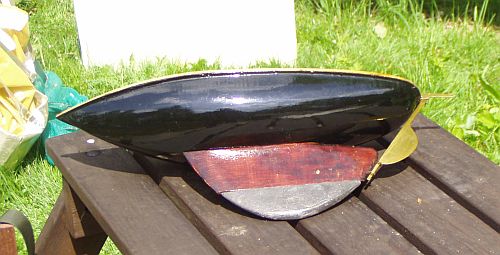
20 inch hull
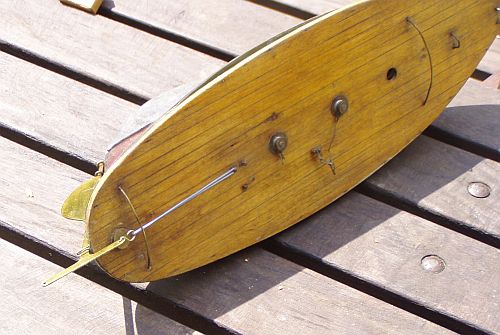
20 inch deck
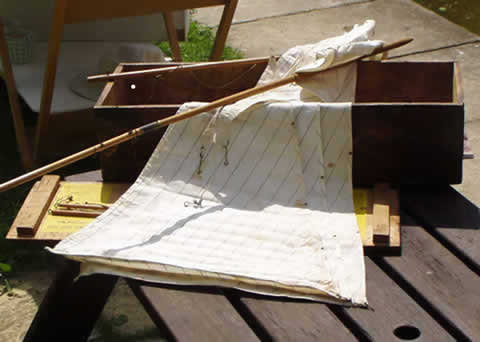
20 inch sails
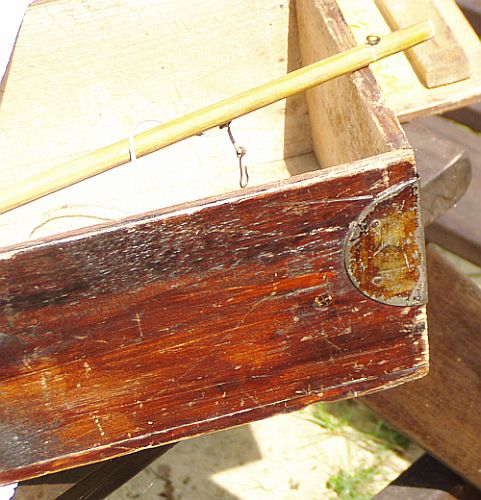
Winford box corner
The following pictures are drawn from a number of sources, including Basil Harley’s article of 1993.
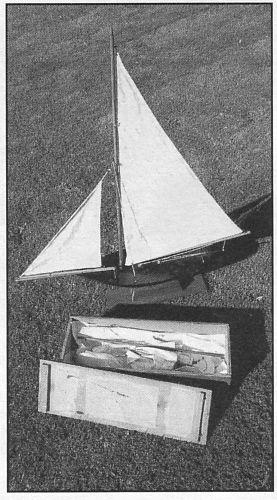
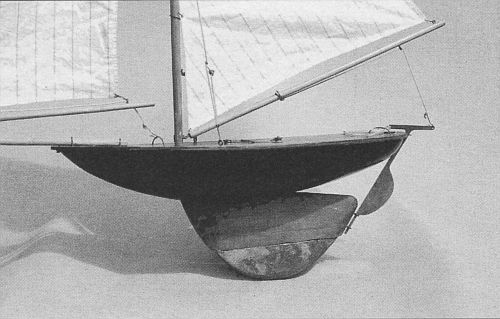
Basil Harley’s 20 inch example with its box and spare rigs.
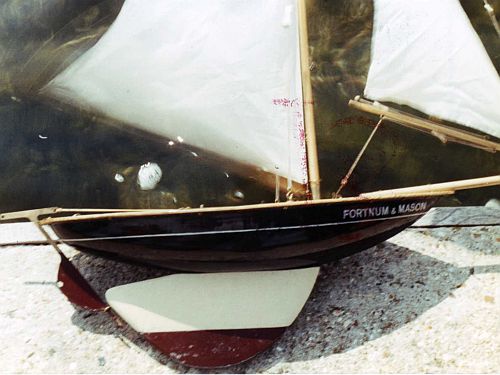
F&M
A small example that had been repainted for use in an F&M window display before being rescued by a VG member.
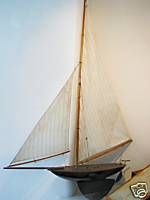
A 20 inch model recently sold on Ebay.
